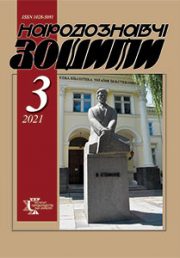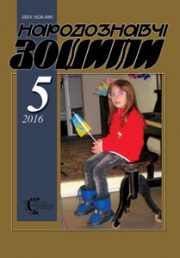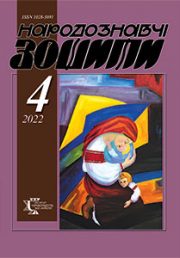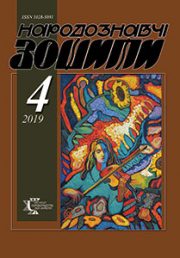The Ethnology Notebooks. 2020. № 5 (155), 1158—1168
UDK 75.03.041.5-055.2:7.071.1(477.87)”193/198″А.Коцка
DOI https://doi.org/10.15407/nz2020.05.1158
FEMALE PORTRAIT IN THE WORKS OF ANDRII KOTSKA DURING 1930—1980
IVANYTSKA Tetiana
- Postgraduate student
- of the Lviv National Academy of Arts,
- 38, Kubiiovycha Street, 79011, Lviv, Ukraine,
- Deputy Director of the College of Arts A. Erdeli
- of the Transcarpathian Academy of Arts, Teacher,
- Transcarpathian region,Ukraine
- Contacts: e-mail: tetyana02@gmail.com
Abstract. The portrait work of the famous Ukrainian artist, representative of the Transcarpathian school of painting Andriі Kotska is considered in the article. It was found that the center of the ideological and thematic orientation of his works throughout his life was the image of a woman. The artist’s favorite characters are village girls, highlanders.
Artistic analysis of women’s portraits of Andrii Kotska is essential for determining the characteristic features of the artist’s manner and awareness of his place among the portraitists of that time — this determines the relevance of this article. The purpose of the study is the characteristics of woman’s portraits of A. Kotska, the interpretation of the female image and the use of means of expression, the evolution of the artist’s manner based on a formal analysis of works.
According to the studied typological properties of images of women, their conditional classification was carried out and 4 main groups were distinguished: the image of a woman-mother, the image of a woman-muse, a woman-worker and a woman-mermaid. The peculiarities of the color of women’s portraits, the nature of the tonal approach of the artist, his application of the contrast of warm and cold tones, different ways of depicting the faces, the interpretation of the image of the model are analyzed. The influence of the founder of the Transcarpathian school of painting Adalbert Erdeli on the formation of the creative personality of Andrii Kotska was revealed, which manifested itself in the decorative generalization and expression of portraits, as well as the differences in the individual vision of woman.
The object of research is the creative work in the genre of female portrait of A. Kotska during 1930—1980, and the subject — the artistic features of portraits, the interpretation of the image of woman.
On the basis of formal analysis and method of figurative — stylistic comparison, the characteristic features, artistic techniques and means of expression used by the artist in his works, as well as a special attitude to color construction, a specific manner of presenting portrayed and changing the manner during different stages of his work. The first stage includes the period of 1930—1940, when the young artist worked as a teacher in the mountain villages of Transcarpathia. The next period was his studies at the Roman Academy of Fine Arts, where he studied the classical heritage of Italian masters. The influence of folk art and folklore is clearly traced, the artist formed an original type of ideal image of a Transcarpathian woman, using the successful findings of previous years. The third stage dates back to the 1970s and 1980s, when the artist continued to appeal to the folk art heritage of Transcarpathia, synthesizing it with the trends of contemporary European art — Expressionism and Impressionism.
Keywords: A. Kotska’s creativity, female portrait, image of woman, color, ethnic type.
Received 6.10.2020
REFERENCES
- Kotska, Andrii, Erfan, F., Miasishcheva, O., & Prykhodko, O. (Eds.). (2011). The book about the life and work of the Peoples Artist of Ukrainian (illustrative material): album. Uzhhorod: Patent [in Ukrainian].
- Biksei, L. (2007). The ideal realized though the image. Art, 1, 22—24 [in Ukrainian].
- Ostrovskyi, G. (1974). Fine art of Transcarpathia. Kyiv: Art [in Ukrainian].
- Kuzma, B., & Danilenko, V.Y. (Ed.). (2014). Life and work of the artist A.A. Kotska in the period of Subcarpathian Russia 1919—1946 rr. Bulletin of the KhDADM (Pp. 56—61). Kharkiv: KhDADM [in Ukrainian].
- Yukhimets, G.M. (1983). Ukrainian Soviet art of 1941—1960. Kyiv: Art [in Ukrainian].
- Prykhodko, O. (2014). «You cant copy! Kotska…» (Video). Program with cyc. «Through time with O. Sorochuk». Retrieved from: https://www.youtube.com/watch?v=6ww9Be3NIzI [in Ukrainian].
- Zaslavska, M. Singer of Verkhovyna. Artkavun.kherson.ua. Retrieved from: http://artkavun.kherson.ua/spivets-verhovini.htm [in Ukrainian].
- Ostriakova, O. (2011). In a wreath in memory of Andrii Kotska. Muzeum space. Retrieved from: http://www.prostir.museum/ua/post/29076 [in Ukrainian].
- Miasishcheva, O. (2018). Autumn colors in the work of A. Kotska. Transcarpathian information and business portal uzhgorod.in. Retrieved from: http://uzhgorod.in/ua/novini/2018/maj/osinni_barvi_u_tvorchosti_a_kocki_predstavlyat_budinku_muzeyi_hudozhnika [in Ukrainian].
- Kotska, Andrii Andriiovych, & Kiyak M.Yu. (Ed.). (2006). From the Art and Industrial School to the Transcarpathian Art Institute Emphasis. Uzhhorod: Grazhda [in Ukrainian].
- Ukrainian art kalendar LB.ua (2015).On May 23, 1911, Andrii Kotska was born, one of the brightest Transcarpathian artists a student of Bokshai and Erdelyi. Retrieved from: https://ukr.lb.ua/blog/art_calendar/305983_23_travnya_andriy_kotska.html [in Ukrainian].
- Syrokhman, M. (2019). Today is 108 years since the birth of our outstanding compatriot Andrii Kotska. Information and analytical internet portal. Retrieved from: https://uzhgorod.net.ua/news/138663 [in Ukrainian].
- Khmelnytsky Regional Universal Scientific Library. «Singer of Maiden Beauty» 105 years since the birth of Andrii Kotska. Retrieved from: http://www.ounb.km.ua/vistavki/kocka/index.php [in Ukrainian].
- Kostiuk, L. «Coding of the image: Valentin Serov, Aleksey Kharlamov, Andrii Kotska, Alfred Bastien and others in a portrait painting of gallery «Euro-Art». Retrieved from: http://euroart-gallery.rv.ua [in Ukrainian].
- Vovchok, V., Stepanenko, M.I., Antonovych, E.A., & Tytarenko, V.P. (Eds.). (2019). Ethnomotives in the works of Transcarpathian artists. Ethnodezign in the context of Ukrainian national revival and European integration. Book 2 (science works). Poltava: PNPU V.G. Korolenka [in Ukrainian].
- Voron, B. (2011). Transcarpathian school of painting: great art from the «small land». Art Almanac Artes. Retrieved from: https://artes-almanac.com/zakarpatska-shkola-zhyvopysu [in Ukrainian].
- Kush, S. Andrii Kotska. Reflective landscape and psychological portrait. Internet edition «Transcarpathian online Beta». (2011). Retrieved from: https://zakarpattya.net.ua/News/89642-Andrii-Kotska.-Reflektyvnyi-peizazh-i-psykholohichnyi-portret [in Ukrainian].
- Current archive of ZO NSHU. Personal life of Andrii Kotska [in Ukrainian].
- Zlyva, V. (2010). Uzhhorod artist Andrii Kotska painted a lot just near the house. Karpatnews rubryka: culture. Retrieved from: https://karpatnews.in.ua/news/8735-uzhhorodskyi-khudozhnyk-andrii-kotska-chymalo-maliuvav-prosto-bilia-budynku.htm [in Ukrainian].







